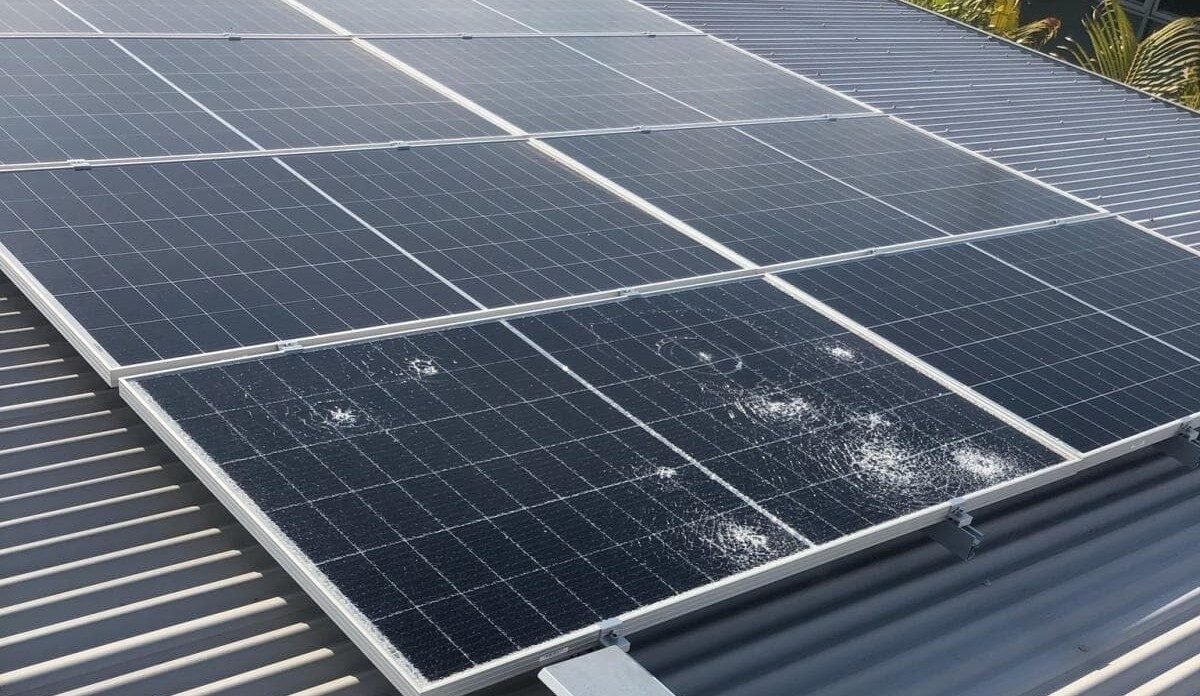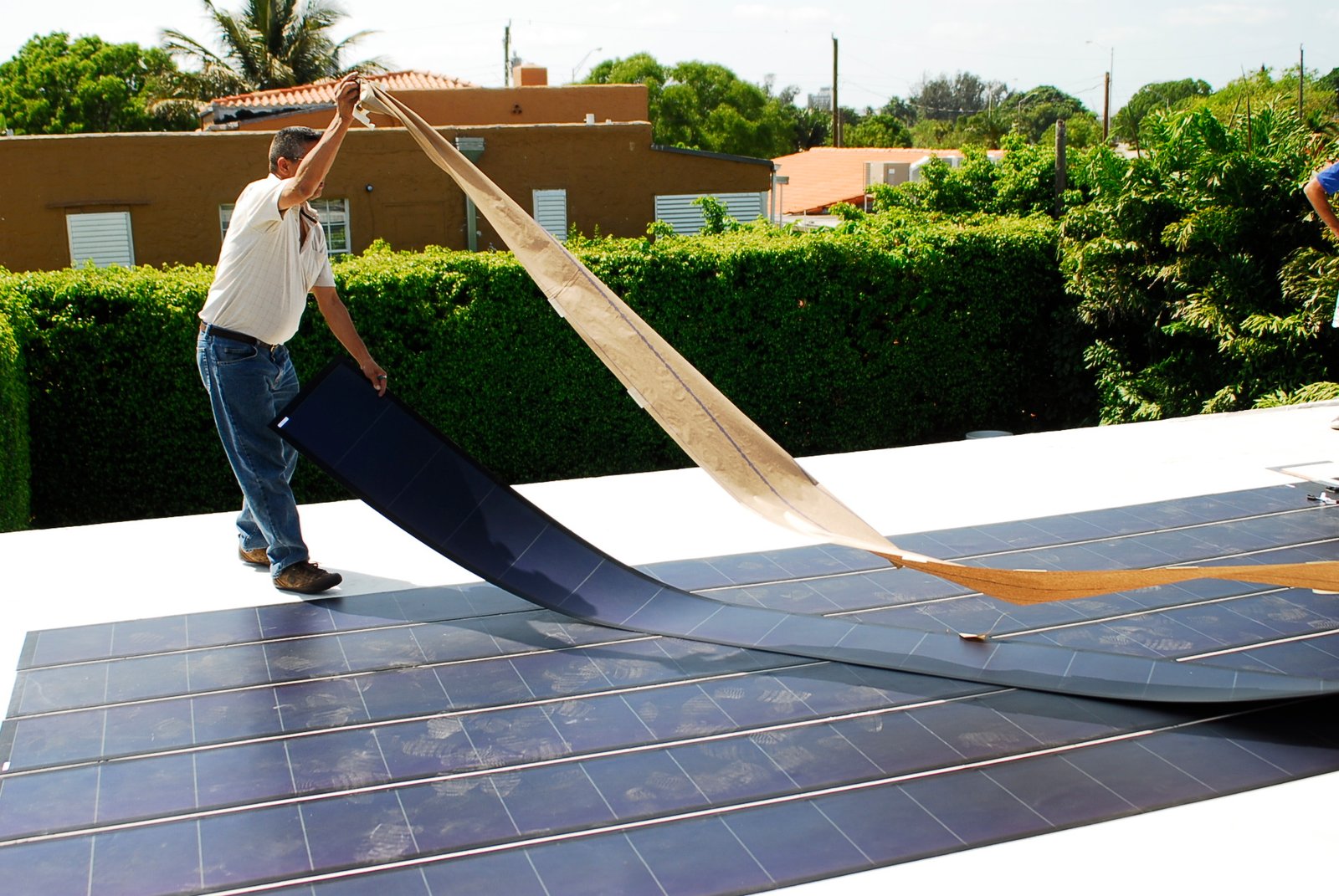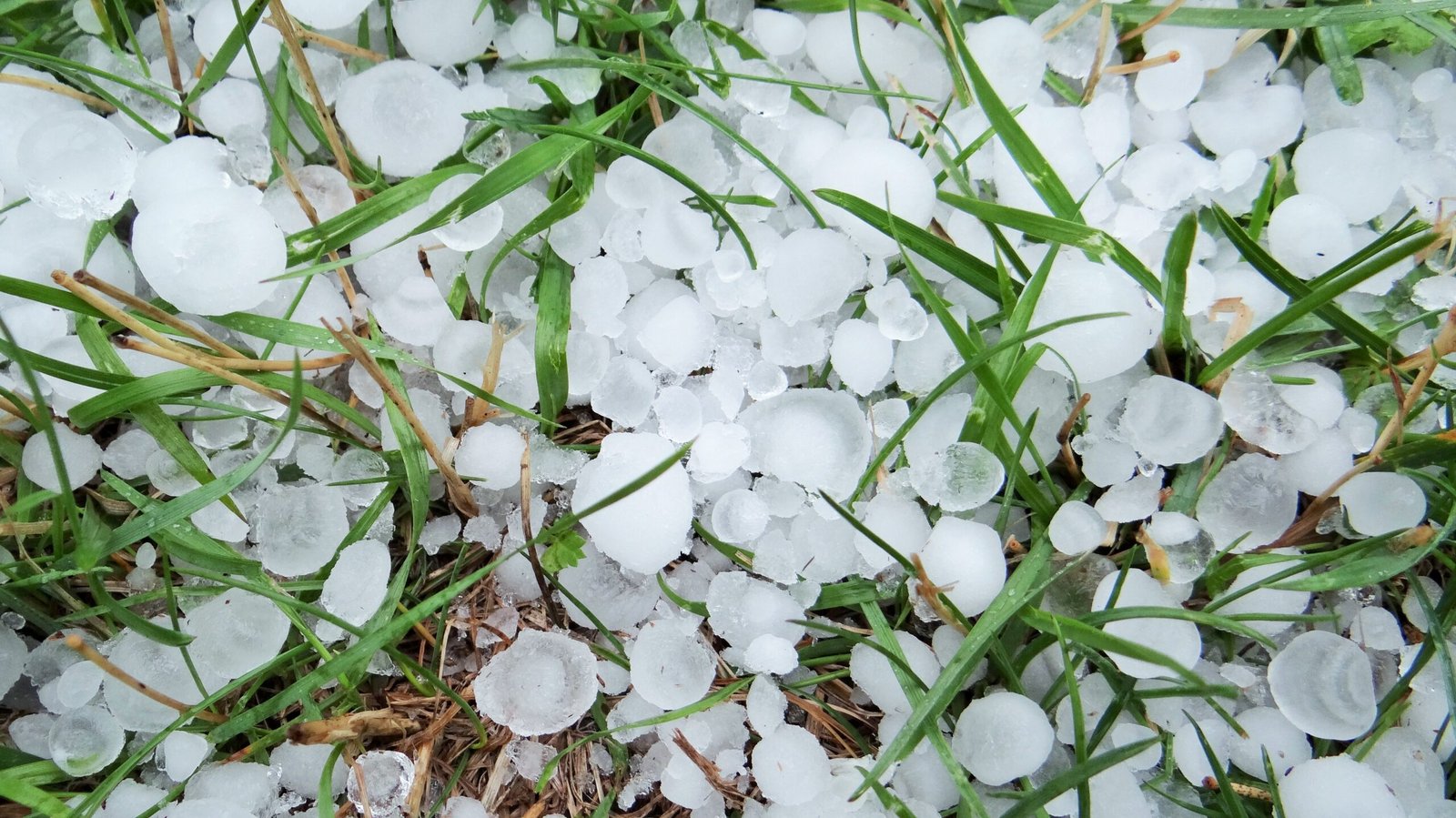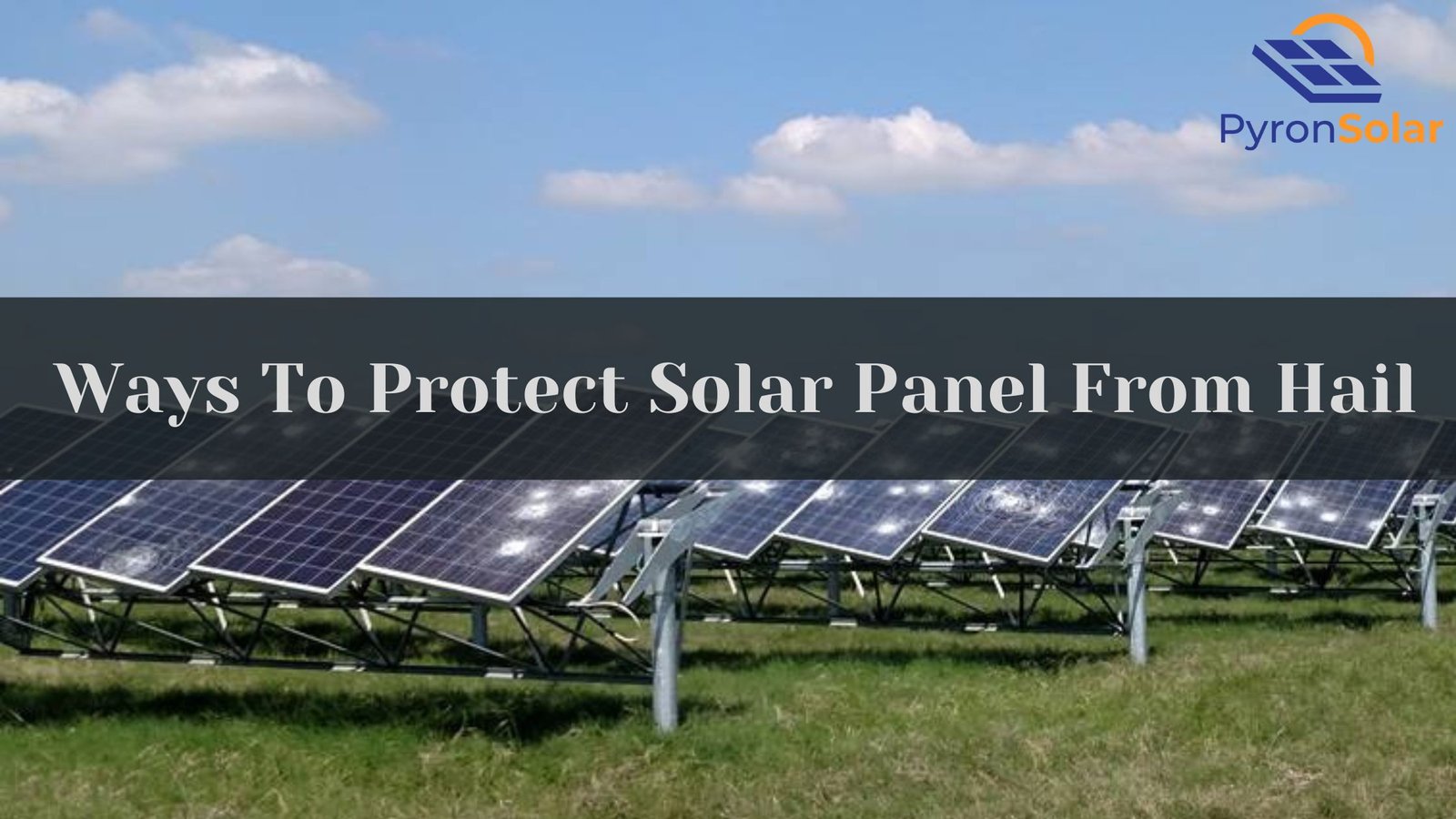Hail can cause substantial damage to solar panels, with a single golf ball-sized hailstone traveling at 40 mph potentially resulting in repair costs of up to $100.
Sounds disastrous? So you can imagine how much damage it would do to our solar panels. Since we can’t stop hailstorms, we need to know some techniques to avoid damage to our solar panels caused by hailstorms.
Using a solar panel hail protector is essential to prevent costly damage from hailstorms, maintain the efficiency of solar panels, and extend their lifespan. It ensures your panels continue to operate at peak performance, maximizing energy production and savings, while providing peace of mind by protecting your investment from unexpected repair costs.
Solar energy is currently one of the best renewable energy sources available. However, one of the biggest concerns for solar panels is adverse weather, such as hurricanes, snowstorms, and strong winds.
As we know, hailstorms are very common in the United States. Hail can have a direct and negative influence on roof-mounted solar panels. Solar panels are prone to severe hail storms, reducing their efficiency and lifespan. We can use solar panel hail protector to prevent disasters.

The best thing about solar panels is that individuals, businesses, etc., can use them. Take precautions to safeguard against hail damage if you have solar panels installed on your residence or place of the business roof.
Most high-quality solar panels can withstand hailstones the size of a golf ball. Your solar panels can sustain minimal damage during a severe hailstorm, depending on how frequently it rains in your area and how giant the hailstones are when they fall.
Hailstorms typically cause two different kinds of damage:
- It can cause damage to the glass surface of a solar panel, but it can be easily fixed.
- It can damage the solar cells of your solar panel, which can be challenging and expensive to repair.
Buying protective coverings, regular maintenance, and responding to weather warnings are all reliable ways to shield solar panels against a hailstorm. The chances of incurring solar panel hail damage are low but never zero.
Solar Panel Hail Protector Overview
What Makes Solar Panels Damage-prone?
Solar panels are made of materials that seem significantly more delicate than the sturdy materials used to construct buildings and automobiles, such as concrete, steel, and wood.
The most common type of solar panel is a “crystalline silicon panel”. These types of solar panels are built of silicon-based photovoltaic panels mounted on frames and protected with toughened glass which make them damage-prone to hail.
There is also a type of solar panel called a thin-film solar panel where Amorphous silicon is used to produce solar cells in this most modern phenomenon of solar panels. A layer of plastic is often used to cover them rather than glass, which makes them lighter and more flexible.

It makes sense that installing a stiff, heavy, and fragile collection of silicon and glass panels on your rooftop puts your solar panel system at risk from climatic factors. Using the solar panel angle calculator for your solar panels you can maximize output and can also lower the risk of damage from a hailstorm.
Problems Caused by Hailstorms to Solar Panels
Hailstones can cause damage to solar equipment:
The force of hailstones striking the surface could harm the device’s internal solar cells and components, even if there are few to no external cracks following a hailstorm.

Once there was a severe storm, where reports of hailstones harming solar panels were inconsistent. Several homeowners, including me, insist there has been no damage, while others draw attention to minor surface imperfections. However, the reality was quite different; my solar panels had been damaged. That’s where I felt the need for good-quality solar panels.
A thick layer of impact-resistant tempered glass protects good-quality solar panels. Tempered glass is known for enduring mild hailstorms. It boasts a high safety certification, allowing it to be used outdoors for many years.
Solar panel efficiency is affected by hail:
Hailstorms can cause a crack in solar panels. As the hailstones hit the surface very hard, they can cause damage to solar panels. Solar panels with cracks on the surface or other damage will still operate. It is less likely that attempts will damage internal components or affect performance.
It is possible that the panel won’t run at its best voltage, output, or efficiency. However, these abnormalities can cause a decrease in solar production. If 15% of the cells inside the panels are damaged due to hail, the unit will achieve 15% less peak voltage.
Cracks on solar panels can lead to water, moisture, or debris getting trapped inside the panels over time. A cracked surface could also create hot spots that cause a fire or irreversible damage to internal components. So, it is better if this issue is detected earlier.
Limitations on hail-damaged solar panels:
Since most warranties do not cover damage from hailstorms, hail is a concern for solar modules. The protection is limited to specific circumstances or incidents in solar securities, including hail under the “environmental factors” category (which is rare).
My point here is that you should check whether the warranty of your solar panels covers hail damage and the scope of the coverage if you live in an area that is likely to experience it.
Additional insurance costs:
Solar arrays on rooftops were generally covered under ordinary homeowners’ insurance. It is, however, critical to ensure that your homeowner’s insurance under the policy’s dwelling section protects hail-related damage to rooftop solar panels.
Be as thorough as possible and determine whether hail is recognized as a “covered peril.” The various damages covered by your homeowner’s insurance are listed in this section of the policy. If the insurance has covered hail damage, you need to check one more thing: the coverage limits. If the coverage limit is low, you have to raise it, which comes with higher costs. Costs vary depending on the rates of the insurer.
You must add coverage to your insurance or purchase a separate policy if it doesn’t cover hail damage to solar panels. Typically, additional fees are added to your current homeowner’s insurance premium when you extend or purchase an insurance policy.
5 Ways to Protect Solar Panels From Hailstorms
Choose high-quality solar panels:
As I have already told you, the quality of solar panels varies. Some boards are more robust than others and can withstand more extreme weather. So, if you are thinking of switching to solar panels for your household or want to add more, be sure to choose a good-quality solar panels for better efficiency.
You need to check whether your solar panels are rated for snowstorms and strong winds with a hail test certification, as it will prove that your solar panels are less likely to get damaged during hailstorms. You can find this information on the product specification chart or the company’s website.
Use a protective cover for solar panels:
One of the best ways to protect your solar panels from hail storms is with solar panel protection covers. The easiest way to describe it is as a durable cover that, when needed, goes over your solar panel to protect it from being damaged by hail or rainstorms.
The only disadvantage is that these coverings block sunlight; you cannot use them continuously. When you cover your solar modules, you must know whether hailstorms or other bad weather are expected.
Weather forecast:
Staying updated on the weather reports could be a great way to plan everything. This will allow you to ensure that your panels are guarded against hail as quickly as it begins to rain or storm. Additionally, you can learn how long the storm will last and how big the hailstones will be.
You can use several mobile applications for this purpose, and some solar monitoring applications can also give you predictions on the weather tomorrow.
Use of Methacrylate on Solar Panels:
Methacrylate is an organic polymer and protective material known for its excellent resistance to hail. Methacrylate can be applied to solar panels in either of two ways: as a thin layer on top of the panel itself or as a spray on the glass surface.
Applying a thin layer of methacrylate that allows sunlight to pass through can be one of the best ways to guard solar cells against damage, even in strong hailstorms.
Inspection and Maintenance:
With coverings or a layer of methacrylate as protection, one should also carry out routine maintenance and quality checks. As previously said, solar panels are very durable. However, if they are not maintained regularly, they will get damaged by the wind and hailstorms and eventually break.
When performing quality checks, you should see if the solar modules are working properly or if their basic shape is stable or distorted.
Is a Hailstorm Really Capable of Damaging Solar Panels?
Large hailstones that strike solar panels can cause damage that compromises both the panels’ warranty and performance. The solar panel’s solar cells lack external physical protection, such as a glass or plastic casing, making them extremely sensitive to both large and small hailstones.
To minimize hail damage, solar panels are often wrapped in protective sheeting. By blocking the light from solar cells that are not being used to power your homes or businesses, this protective sheeting might reduce the effectiveness of your solar system.
Suppose the damage to your solar system is severe enough. In that case, it could fail to operate correctly, leading to a loss of energy efficiency or an interruption of solar operation.
Some additional weather-related factors besides hail can harm the solar panels, like strong winds, lightning storms, and snowfall. The buildup of snow and ice, as well as fallen branches, can also damage solar panels.
Solar power can continue to be a reliable and sustainable energy source for your home or business by undergoing appropriate system care and maintenance. These guarantees ensure your panel’s resilience remains at the highest level possible.
Frequently Asked Questions:-
- Are solar panels hail-proof?
Yes, solar panel systems are hail-proof, designed to handle small and medium-sized hailstones. In the case of large hailstones, the right kind of protection can lessen the damage caused to solar panels.
- What is solar panel hail damage insurance?
As I already told you, hail can sometimes cause severe damage to solar panels. So, to prevent this damage, many companies now require hail coverage on homeowners’ policies in some hail-prone areas of the country.
- Who pays the replacement cost for solar panels?
Homeowner’s insurance covers replacement costs. If necessary, the damaged panels will be replaced with new ones. These replacement costs may vary depending on your insurance policy and the rules and regulations regarding solar panels in your area.
- How do I fix hail-damaged solar panels?
Suppose you have hail damage on your solar panels. In that case, the best thing to do is to call your solar installer or a professional solar panel repair company. They will be able to assess the damage and give you the best solution on how to fix it.
Conclusion
Installing a solar power system can be one of your best decisions. Even so, keeping them safe in adverse weather can be difficult. Hail and storm damage is a common issue for those considering installing solar panels in their homes or businesses.
Consider protecting your solar panels from extreme weather conditions if you want your system to last as long as possible. Hail damage is not as high as it seems.
According to research, solar panels are durable and resistant to hail damage. One will experience a significant financial loss if the solar panels are damaged by wind or hail. It can reduce the energy generated and the amount you can save on your electricity bill.
To avoid wasting precious resources and to ensure that your solar panels will continue to produce sustainable energy for many years to come, it is an excellent choice to take a few easy precautions to safeguard them from more severe weather.
However, I suggest you keep in mind the ways mentioned above to protect solar panels from hailstorms, which will help you protect solar panels from hailstorms.
Ray is an avid reader and writer with over 25 years of experience serving various domestic and multinational private and public energy companies in the USA.

